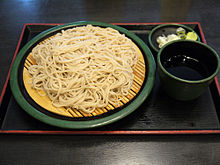Soba and udon are two very popular native Japanese foods. For culinary lovers, Udon and soba are certainly familiar. In Indonesia, soba and udon are also widely served in Japanese restaurant menus.
At first glance it looks similar because soba and udon are similar foods with noodles. Only the texture and how to eat it are different. However, if you stop by the Japanese restaurant, how to enjoy udon and soba is different.
Here’s the right way to eat Japanese Soba.
Soba is a rather brown colored noodle and made from sobako, flour derived from mashed buckwheat seeds. Soba has many good benefits for health, especially for diet because it can make the stomach last full.
How to enjoy buckwheat varies, depending on each taste. There are those who dip soba into cold broth (zaru soba) or pour hot sauce (kake soba) into buckwheat. There are two types of soba broth, namely sobatsuyu and sobajiru.
These two types of soba broth are made from algae or edible seaweed (konbu), dried skipjack and thinly sliced (katsuobushi), shoyu (soy sauce) and dashi (broth) and mirin.
For those who are Muslim, mirin non-halal food ingredients. You can replace it with fresh grape juice mixed with lemon juice and add sugar.

